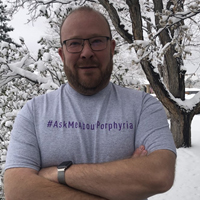Acute Intermittent Porphyria (AIP)

MIKE BOONE A MEDICAL HERO
In late 2002, after a yearlong battle, I was diagnosed with Acute Intermittent Porphyria (AIP). At first, I was relieved to finally have answers. I wasn't the first in my family to be diagnosed. In the late 1950's, my great uncle was diagnosed and died of the disorder. My grandmother would follow in the early 60's Aand died at the young age of 28. My mother was also diagnosed in the mid 1990's.
Needless to say, I thought I understood the seriousness of the situation, but after learning what my treatment options were, and experiencing so many attacks, I became nervous. How could I support my family. I n researching the disorder, I quickly found the American Porphyria Foundation/APF. Through them, I learned about Panhematin and jumped at the chance to have my first infusion. After years of horrendous pain and illness and repeated attacks of AIP, I finally had my life returned to me. I wanted to give back so I began joining research studies.
The first study I enrolled in was the Longitudinal Study, which was straight forward. It required no travel and only one time did I have to send any samples. It was a simple blood draw at my local doctor’s office and then mailed to Salt Lake City. I have remained in the study and once in a great while, I fill out more papers with questions about how I am doing.
The second study I took part in was the Panhematin study in Galveston, Texas at the University of Texas Medical. This study required me to fly to Galveston, Texas and stay in the hospital for four days. The research grant paid for all of my travel expenses and all study related hospital expenses. The APF arranged all the travel. Again, this study had a simple procedure. Once I began feeling as though an attack was coming on, I contacted the APF and they made the travel arrangements. The next day I flew into Houston where a car service picked me up and drove me to UTMB. This study was a double-blind study, which means that neither I, nor the doctors and nurses know if I was getting the Panhematin or a placebo. Only the pharmacist knew. I had to wear a blindfold, the tubing and medicine was wrapped in foil, and a sheet was also placed between me and the IV and bottle. This happened once a day for four days, and I was also on normal saline with 10% dextrose constantly while I was there. Things went smoothly and before I knew it, I was on my way back home to Colorado feeling good that I had helped my fellow patients.
The next trials was for Givosarin, a then new treatment for acute porphyria that reduces the number of attacks. Unfortunately, I got the placebo instead of the drug, but I persevered because having placebo results for a research trial is as important as the real drug. Now I am on Givosarin/Givlaari, which has indeed reduced my attacks and in my case, has worked well. The Givlaari gave me a great deal of relief and when I did have a breakthrough attacks, I have Panhematin infusions to stop them in their tracks. Between the two drugs, I was able to become employed again and gain my life back.
Recently, my life has been interrupted with a cancer diagnosis. To make matters worse, one of the treatments caused me to have a porphyria attack. Again, I contacted friends at the APF and they not only provided a concerned shoulder to lean on, but they also helped with the attack. I am in treatment waging a new battle with confidence. Research resulting in new treatments brought me through tough porphyria battles and will bring me to good health soon. I encourage all of you to join a research trial for the benefit of all. Editors note: Our prayers are with You Mike. Thank you for your years of service as a research volunteer. You are our Medical HERO,